A Comprehensive Review of Resilient Data Recovery in Cybersecurity
Keywords:
Cyber resilience; Data resiliency; Disaster Recovery as a Service; Cloud computing; Customer Relationship Management; Software as a Service; Cybersecurity strategies.Abstract
This review explores resilient data recovery strategies and innovations in cybersecurity to address evolving cyber threats in the current digital landscape. It begins by highlighting the pressing need for cyber resilience amidst emerging technologies and sociotechnical vulnerabilities. Through a comprehensive literature review, this study analyzes various studies that focus on data provenance applications, continuous data protection, optimization models, fault tolerance algorithms, and disaster recovery models using cloud computing. The research methodology outlines a systematic approach to exploring cyber resilience and data recovery strategies, emphasizing the critical analysis of different approaches. The notable strategies discussed include backup and replication, encryption, continuous data protection, DRaaS Disaster Recovery as a Service), threat detection, and AI/ML techniques. Additionally, a detailed disaster recovery model for CRM (Customer Relationship Management) using cloud computing is presented to illustrate functional blocks and connectivity features. Key findings underscore the importance of robust data recovery mechanisms and the integration of innovative technologies, such as DRaaS and SaaS (Software as a Service). The paper concludes by highlighting potential areas for further research, including the deeper integration of DRaaS and SaaS, automation, blockchain technology, user-centric recovery solutions, and regulatory compliance considerations. Overall, it provides valuable insights for organizations seeking to enhance their data recovery capabilities and mitigate cyber threats in an increasingly dynamic digital landscape.
Downloads
Published
How to Cite
Issue
Section
License
Copyright (c) 2024 Journal of Information Systems Research and Practice

This work is licensed under a Creative Commons Attribution-ShareAlike 4.0 International License.





